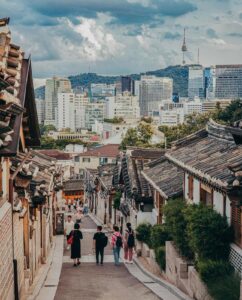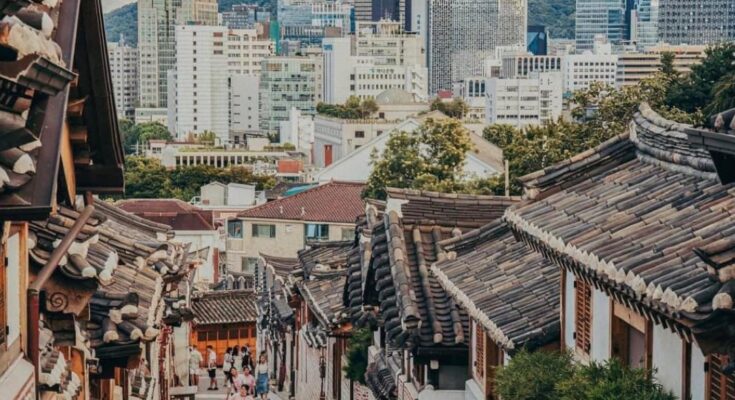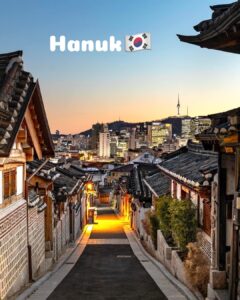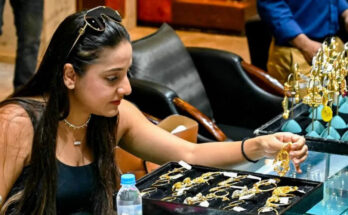Bukchon Hanok Village (Korean: 북촌한옥마을) is a residential neighborhood in Jongno District, Seoul, South Korea. It has many restored traditional Korean houses, called hanok. This has made it a popular tourist destination, which has caused some friction with the residents who live there.[1]
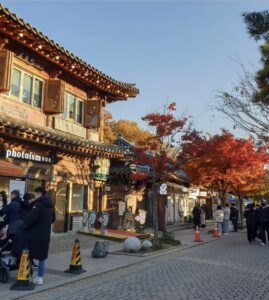
History
The area of Bukchon, which consists of neighborhoods: Wonseo-dong, Jae-dong, Gye-dong, Gahoe-dong and Insa-dong, was traditionally the residential quarter of high-ranking government officials and nobility during the Joseon period. It is located north of the stream Cheonggyecheon and Jongno, hence named Bukchon, which means north village.[2][3]
Tourism
The Bukchon Hanok Village is preserved in modern society and is renewed as a unique tourist sight. An alleyway of traditional houses lining the street is like time travel. In 1997, amid the movement of urbanization in Seoul, the Asian financial crisis occurred. Under huge financial damage, the Korean government resolved to preserve traditional hanok instead of removing them as old buildings.[4] The movement for the preservation of hanok occurred in 2000.[5] Close to tourist spots such as Gyeongbokgung Palace and Changgyeonggung Palace, Bukchon Hanok Village is an ideal place to learn about Korean traditional architecture and cultures. A poll of nearly 2,000 foreign visitors, conducted by the Seoul Metropolitan Government in November 2011, stated that exploring the narrow streets of Bukchon was their fourth favorite activity in Seoul.[6]
According to data by the Bukchon Traditional Culture Center, 30,000 people visited the area in 2007. However, after the village was featured in television programmes, such as 2 Days & 1 Night and Personal Taste, the number rose to 318,000 in 2010.[7] Between October 2016 and June 2017, the Tourism Research institute reported that an estimated 37,100 people visited during the week and 54,200 people visited on weekends.[1]
According to the Korea JoongAng Daily, Bukchon Hanok Village was the top destination in Seoul for tourism.[8] Following the rise in popularity, the Korean government is also putting effort into developing Bukchon Hanok Village as a new tourist destination. For example, traditional hanok are renovated as cultural centers, guesthouses and hotels, restaurants, and tea houses.[9] In 2014, there were about 920 hanok institutions for commercial uses.[10] Artisan businesses like Kum Bak Yeon, which works with gold leaf on clothing, are found in some of these.[11]
Tourists can visit hanok that remain untouched. Also, renovating hanok into cafes is a current trend. Hanok cafes are a type of cafe that offers Korean classic desserts such as rice cake and porridge, as well as trending ones. The reason for the increased population of hanok cafes is that they offer visitors time to enjoy foods and drinks while experiencing the inside of traditional architecture.Moreover, some hanok are renovated into workshops for artists and designers.[12] Those young people purchase and renovate old hanok with sustainable materials.[13] Other than sightseeing, there are places where tourists can enjoy various kinds of activities. For example, one can experience the kimchi-making process at the Seoul Kimchi Academy.[14] In addition, the Korean and Seoul organizations offer walking tours around Bukchon Hanok Village that offer tourists a rich experience and understanding of the unique place. Other activities include pedicab tours, photoshoots, and the rental service of hanbok, Korean traditional clothes.
